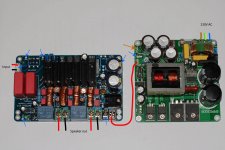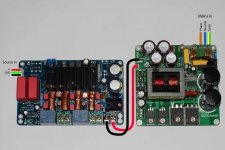Hello,
I've bought a Hifimediy T1 amp together with the SMPS300R and need to wire them up. I basically have no previous experience with such things and was hoping someone would be kind to help me do the wiring correctly. I've attached a photo for illustration. I have the following questions:
I've bought a Hifimediy T1 amp together with the SMPS300R and need to wire them up. I basically have no previous experience with such things and was hoping someone would be kind to help me do the wiring correctly. I've attached a photo for illustration. I have the following questions:
1) 230V AC goes into the SMPS on the top right. There are three connectors here. How should I connect phase, neutral and ground/earth? On the photo I’ve marked ground/earth as the center connector, but not sure if this is correct?
2) DC power comes out on the top left of the SMPS. There are three connectors: "Positive out", "Negative out" and "Ground". How do I connect these to the amp power inputs? I figured the "Positive" and "+" go together, but what about the rest? “Negative” (orange arrow) to “GND” or “Ground” to “GND”?
3) The audio input on the amp has three connecters: “+”, “–“ and “GND”. My source only has “+” and “–“, so what should I do with the “GND”?
4) In fact there are many “GNDs” on the amp that I’m not sure what to do with. I’ve marked all the GND connectors with blue arrows. Could any of you tell me which ones I need to connect and which ones I can leave out?
Thanks for your help.2) DC power comes out on the top left of the SMPS. There are three connectors: "Positive out", "Negative out" and "Ground". How do I connect these to the amp power inputs? I figured the "Positive" and "+" go together, but what about the rest? “Negative” (orange arrow) to “GND” or “Ground” to “GND”?
3) The audio input on the amp has three connecters: “+”, “–“ and “GND”. My source only has “+” and “–“, so what should I do with the “GND”?
4) In fact there are many “GNDs” on the amp that I’m not sure what to do with. I’ve marked all the GND connectors with blue arrows. Could any of you tell me which ones I need to connect and which ones I can leave out?
Attachments
You can visually trace how things are wired up, but better to confirm with a multimeter...
1) Phase needs to go through the fuse before reaching the rest of the board, so logically it would be next to the fuse.
The two small blue capacitors beside the AC input connector, they should be connected as (phase)---||---(earth)---||---(neutral)
2) Googling reveals SMPS300R "can be configured for single output voltage or for dual output voltage, in range of 24V to 48V or +-24V to +-45V", so negative may mean -V, 0V, or unconnected depending on how it is configured. Just measure which two pins gives the voltage. I'm guessing +V and GND. (Double-check before connecting the amp board.) In this case, the GND beside the V+ on the amp board connects to GND on the SMPS.
3) If this is a stereo amp, then + is one channel, - is the other. The center pin would be signal ground. Trace the wiring and check TC2000 datasheet to see which pin is L or R.
4) All these GND points should be connected to each other via PCB traces on the board. They are there because some things may need to be grounded e.g. the volume control pot and it is more convenient if there is a GND point next to the component rather than pulling a separate wire.
But really, the seller should be the one providing the info.
1) Phase needs to go through the fuse before reaching the rest of the board, so logically it would be next to the fuse.
The two small blue capacitors beside the AC input connector, they should be connected as (phase)---||---(earth)---||---(neutral)
2) Googling reveals SMPS300R "can be configured for single output voltage or for dual output voltage, in range of 24V to 48V or +-24V to +-45V", so negative may mean -V, 0V, or unconnected depending on how it is configured. Just measure which two pins gives the voltage. I'm guessing +V and GND. (Double-check before connecting the amp board.) In this case, the GND beside the V+ on the amp board connects to GND on the SMPS.
3) If this is a stereo amp, then + is one channel, - is the other. The center pin would be signal ground. Trace the wiring and check TC2000 datasheet to see which pin is L or R.
4) All these GND points should be connected to each other via PCB traces on the board. They are there because some things may need to be grounded e.g. the volume control pot and it is more convenient if there is a GND point next to the component rather than pulling a separate wire.
But really, the seller should be the one providing the info.
better yet to go back to the retailer and ask how to connect up the kit of bits.
If they tell you wrong and it blows up it is their fault and you get your money back (all of it, including postage etc.)
This is confirmation of the last line in the previous reply.
If they tell you wrong and it blows up it is their fault and you get your money back (all of it, including postage etc.)
This is confirmation of the last line in the previous reply.
Thanks for your help! I'll take your advice and double check with Hifimediy, although PandazYa you seem to know how this is done 🙂
Another question: If I don't use any of the GND connections, does this then mean that I shouldn't connect any of the boards to the enclosure's chassis? Looking at other DIY amps I often see that the boards are "grounded" to the chassis... 😕
Another question: If I don't use any of the GND connections, does this then mean that I shouldn't connect any of the boards to the enclosure's chassis? Looking at other DIY amps I often see that the boards are "grounded" to the chassis... 😕
Test without first. If you don't have any issues without just leave it. If you notice some noise connect to the gnd.
I have not connected gnd from amplifier board and everything is dead silent 😉
And you're right, always check twice before doing something is the way to go especially when 230v is involved!
I have not connected gnd from amplifier board and everything is dead silent 😉
And you're right, always check twice before doing something is the way to go especially when 230v is involved!
All exposed conductive parts must be connected to Chassis.
The chassis must be permanently connected to the PE wire in the Mains cable.
The amplifier will become noisier after you complete these Safety connections. Reducing that excess noise to acceptable levels will take time and skill.
The chassis must be permanently connected to the PE wire in the Mains cable.
The amplifier will become noisier after you complete these Safety connections. Reducing that excess noise to acceptable levels will take time and skill.
All right, I wrote the dealer and he confirms that the wiring as showed in the attached photo is correct. Also, he says that I don't have to ground the amp as this sometimes can cause some noise issues. However, if I choose to ground, he says I can take ground from the screw mounting holes on the amp.
But I'm still confused regarding the grounding to chassis. People don't seem to agree here 🙂 One says it's not needed, but if noise is noticed I can connect to ground. Another says that ground is needed for safety, but it may cause noise 😕
Andrew, you say it takes "time and skill" to reduce the excess noise caused by grounding to chassis. Can you elaborate on this? Or perhaps point me in a direction where I can read more about this?
Thanks again. I really appreciate your help!
But I'm still confused regarding the grounding to chassis. People don't seem to agree here 🙂 One says it's not needed, but if noise is noticed I can connect to ground. Another says that ground is needed for safety, but it may cause noise 😕
Andrew, you say it takes "time and skill" to reduce the excess noise caused by grounding to chassis. Can you elaborate on this? Or perhaps point me in a direction where I can read more about this?
Thanks again. I really appreciate your help!
Attachments
read
Audio Component Grounding and Interconnection - diyAudio
It's in latest articles on the Forum front page.
Audio Component Grounding and Interconnection - diyAudio
It's in latest articles on the Forum front page.
- Status
- Not open for further replies.
- Home
- Amplifiers
- Class D
- First build: Basic wiring question


